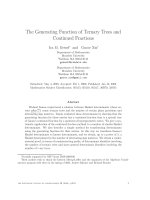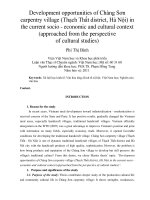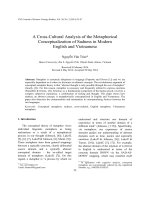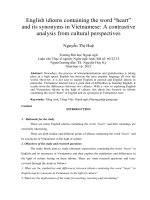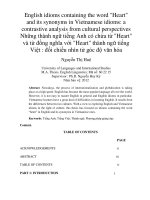CROSS CULTURAL COMPARE AND CONTRAST THE SPEECH ACT OF COMPLAINT PATTERNS IN ENGLISH AND IN VIETNAMESE LANGUAGE
Bạn đang xem bản rút gọn của tài liệu. Xem và tải ngay bản đầy đủ của tài liệu tại đây (169.53 KB, 9 trang )
HUE UNIVERSITY OF FOREIGN LANGUAGES
ENGLISH DEPARTMENT
CROSS- CULTURE COMMUNICATION
END OF TERM ASSIGNMENT
COMPARE AND CONTRAST THE SPEECH ACT OF COMPLAINT
PATTERNS IN ENGLISH AND IN VIETNAMESE LANGUAGE
Instructor
: HOÀNG TỊNH BẢO
Student’s name: NGUYỄN THỊ HIỆP
Class
: SƯ PHẠM TIẾNG ANH LT-K11
April, 2018
0
TOPIC: Compare and contrast the speech act of complaint patterns in English
and in Vietnamese language.
As we know, each country has a different culture. Culture is the social
behavior and norms found in human societies. Culture includes all aspects of
human life that are learned and shared by members of a society. Specially, culture
is everything that people have, think and do as a member of a society respectively.
Cross cultural communication between countries help us understand each other
better. Cross-cultural communication is a field of study that looks at how people
from differing cultural backgrounds communicate, in similar and different ways
among themselves, and how they endeavor to communicate across cultures.
Intercultural communication is a related field of study. With an effort to improve
the communicative competence of Vietnamese, many cross-cultural studies has
been carried out on the usage of common used speech acts such as inviting,
thanking or requesting. Among them, complaining is considered as a socially
complex and culturally specific act for the fact that it is one of the face threatening
acts. A complaint is verbal, fully intentional and indicates something bad happened
to the speaker. In workplace, the Vietnamese officers working in a multicultural
environment should be attended to politeness strategies to have more effective
communication. Specifically, it studies the advisability of making complaints and
the choice of complaint strategies of English and Vietnamese workers. Subjects of
the study were English and Vietnamese who are working in the office in Vietnam
and England.
There are many studies regarding the speech act of request, giving and
receiving compliments, promising or addressing terms and so on have been
carried out in Vietnam and in other interlanguage of English learners of
1
different language backgrounds, but little attention is paid to the speech act of
complaining which is used to express common feelings like pain, discontent or
dissatisfaction about something. In other words, complaining is an area that not
much research has been dedicated. This is surprising because everyone
complains sometimes and some people seem to complain all the time. We
frequently hear others or ourselves complain about the weather, a test they
have just taken, about their jobs, their economic status, traffic, other’s
behaviors, etc. So often are these remarks and expressions of dissatisfaction
that we do not notice how much these expressions are used and how facethreatening those speech acts are. And although complaints are a common
feature of our everyday lives, it is surprising the little attention that has been
paid to this topic. Secondly, the strategies the Vietnamese choose to carry out
those speech acts are not the same as those the English or people from different
societies do since the ways in which a given function is realized may differ
from one language to another, even though communicative functions appear to
exist across languages. In other words, they may speak in different ways – not
only because they use different linguistic codes, involving different lexicons
and different grammars, but also because their ways of using the codes are
different (Wierzbicka, 1991: 67) and therefore, a systematic and scientific
observation on complaining strategies is virtually necessary.
Of all the issues in the general theory of language usage, the speech act
theory has probably aroused the widest interest. It has undergone serious
investigation by different theorists such as Austin (1962), Grice (1957,
1975), Hymes (1964), Searl (1969), Levinson (1983), Brown and Yule
(1983), Yule (1996). Blum-Kulka and Kasper (1982:2) emphasize that “the
study of speech acts is to remain a central concern of pragmatics, especially
2
cross-cultural pragmatics”. According to Austin’s theory, the speech act
theory is originally developed by the Oxford philosopher of language J.L.
Austin. In his famous work, "How to do things with words," Austin outlines
his theory of speech acts and the concept of performative language, in which
to say something is to do something.
To make the statement “I promise that p” (in which p is the
propositional content of the utterance) is to perform the act of promising as
opposed to making a statement that may be judged true or false.
Performatives cannot be true or false, only felicitous or infelicitous. Austin
creates a clear distinction between performatives and constantives,
statements that attempt to describe reality and can be judged true or false,
but he eventually comes to the conclusion that most utterances, at their base,
are performative in nature. That is, the speaker is nearly always doing
something by saying something. For English, what the speaker is doing is
creating social realities within certain social contexts. For example, using an
explicit performative, to say “I now pronounce you man and wife” in the
context of a wedding, in which one is marrying two people, is to create a
social reality, in this case a married couple.
Complaint is one kind of speech act used commonly in interaction. It is a
face - threatening act and can be expressed in different forms. To gain the
social goal of polite interaction, the choice of particular form should be
considered together with various factors like social variables and politeness
realization. There have been several attempts on establishing a categorization
of complaint strategies by different linguistics. One of the popular
classifications of complaint strategies was provided by Olshtain and Weinbach
(1987) when they studied the speech act of complaint as produced by native
3
and non - native speakers of Hebrew. These researchers developed five
categories of speech acts that were based on severity of the complaint for a
specific scenario, in which one colleague had waited for another colleague,
who arrived late to a scheduled appointment. The five categories were: (1)
below the level of reproach, “No harm done, let’s meet some other time;” (2)
disapproval, “It’s a shame that we have to work faster now;” (3) complaint,
“You are always late and now we have less time to do the job;” (4) accusation
and warning, “Next time don’t expect me to sit here waiting for you;” and, (5)
threat, “If we don’t finish the job today I’ll have to discuss it with the boss”
Tanck (2002:7) classified the complaint into four components, especially
in native speakers’ production of complaints. These components are: (1)
excusing self for imposition: “Excuse me for interrupting,” (2) establishing
context or support: “I placed an order last week,” (3) a request: “Can you
please look for it?” and (4) conveyance of a sense of urgency: “I need it right
away.” Another categorization was made by Trosborg (1995), based on her
own directness level of complaint. In this classification, four main categories
of complaint strategies, comprising eight sub-strategies are set up: no explicit
reproach, expression of disapproval, accusation and blame. This one is also the
model for this paper’s theoretical framework to make a comparison on
complaints made by Vietnamese and English in the workplace.
Thuan (1998) carried out the study to investigate complaining and
responding strategies in terms of what has been done and what has not been
done in English and Vietnamese. He studied the form of complaining and
responding, identified the similarities and differences of the speech acts
concerned between two languages. One of the interesting differences lied in
politeness and face strategies. He pointed out that more often than not the
4
English people chose positive politeness strategies: they went directly to the
problem and in case of refusal; both parties still retained face after
conversation. Vietnamese, on the other hand, often carried out negative
politeness strategies to make the addressee feel good and highly appreciated
even in the case of not accepting the complaining. Moreover, this contrastive
study also aimed at pointing out the difficulties and pragmatic problems which
Vietnamese learners may face when learning these speech acts in English,
helping them avoid getting into troubles with culture specific problems.
To make more clearly understand about this topic which is “compare
and contrast the speech act of complaint patterns in English and in
Vietnamese language”, I would like to focus on some aspects in work place.
First of all, choice of strategy in equal power settings, for example: In the
settings where speaker and hearer are equal in power, English and
Vietnamese subjects differed in the trend of indirectness regarding the
choice of strategy. English speakers tended to show more directness in their
complaints than Vietnamese ones. The common utterances to accuse hearer
directly in English were: “You’ve made a lot of noises, recently”, “Why can’t
you keep silent when you return home?” or “You have chosen to break the
rule”. Meanwhile, Vietnamese speakers tended to express their annoyance
by saying such things as: “Mày biết là tao khó ngủ mà?”(You-know-I-findhard- sleep-didn’t-you?) or “Chúng ta đã quy định không đi về khuya và
làm ồn sau 11h cơ mà”(No-noise-after-11h) or even more direct “Ầm ĩ
quá, không thể nào ngủ được”(So- noisy-I-can’t-sleep). It can be inferred
that there is a statistically significant difference between the choices of
strategies direct accusation and annoyance of English and Vietnamese
speakers. Moreover, appears that English and Vietnamese speakers differed
5
in the trend of indirectness. In situation, one people said such things as “The
smoke from your cigarette is bothering me greatly”, “You are contaminating
the atmosphere”, or “You are breaking the rule” or something even more
direct “How on earth did you manage to be thoughtless” or “You are not
supposed to smoke in train”. Meanwhile, Vietnamese tended to be milder in
saying such things: “Khói thuốc của anh làm tôi khó chịu” (Your-smokebothering-me), “Anh biết là biển ghi không được hút thuốc lá” (Sign-indicateyou-not-smoke-here) or “Anh nhìn xem phòng toàn khói thuốc” (Room-fullsmoke).
Secondly, the choice of complaint strategies in higher power settings. In
general, the English and the Vietnamese subjects have some similarities in their
choice of strategies for their complaints when the complainer has higher power
than the complainee. The speaker complained to his or her assistant, the choice
of complaint strategies by both groups differ as most of the English choose to
employ direct accusation as illustrated in “You are late. What’s your reason?”
whereas the majority of Vietnamese tend to use Modified blame like “ Lần sau
đừng đi muộn đấy” (Don’t be late next time ). None of both groups choose to
keep silence or choose explicit condemnation towards person. There is also
none of the English subjects choose to give hint, but six out of thirty
Vietnamese speakers employ this strategy. Another point should be taken into
aspect here is the use of directive acts like threat by some English and
Vietnamese with expression like: “There is no excuse for being late and if you
keep it up, you will be replaced” or “Anh lần sau nên đến đúng giờ nếu không
thì có hình thức phạt dành riêng cho người đi muộn” (You should be on time
next time or else there will be penalty for you”). In addition, there are also a
number of English subjects tend to use modified blame and explicit
6
condemnation towards action with some down graders and disarming strategies
and as illustrated in “Could you lower your voice a little bit?” or “Why you are
making noise? Look, I can’t focus on my work.” Meanwhile the Vietnamese
also use these strategies but without those “softening” devices, e.g. “Trật tự để
người khác làm việc, giờ này là giờ nói chuyện à?” (Keep silence to let others
work, this is not time for chatting).
In a nutshell, many Vietnamese show their agreement with English
speakers in their choice of complaint strategies in high power situation.
However, the utilities of internal and external modifications by these two groups
are quite different. While down graders and disarming strategies appear in many
complaints made by English, they are not preferred by Vietnamese.
With respect to the lower power settings, most of the English subjects think
that they should complain to their superior while such decision is not preferred
by the majority of Vietnamese subjects. For the choice of complaint strategies,
while the English often choose such indirect strategies like hint or annoyance,
the Vietnamese tend to say nothing to complain, which has been reflected to
some extend in their choice of advisability of making complaints. In equal
power situations, most of the Vietnamese speakers seem to be unsure about the
advisability of making complaints while the majority of English think they need
to complain in such situations. The strategies the English tend to choose for
such settings are once again the first two strategies hint and annoyance.
Meanwhile the Vietnamese either choose to keep silence or some more direct
strategies like direct accusation and modified blame. In the last category of
situations, where the complainer is of higher power than the complainee, it has
showed that both Vietnamese and English subjects think it is advisable to make
complaints to their inferiors. In addition, they also share agreement in
7
employing some strategies like direct accusation and modified blame. The
findings also reveal some differences between two groups of subjects in their
use of internal and external modifications. English subjects tend to add such
down graders as a bit, a little, please, etc. As well as some preparatory and
disarming strategies to their complaints, whereas Vietnamese subjects often
include upgraders like too, much, etc. while they complain. These similarities
and differences above suggest some interesting implications for Vietnamese
officers to have better communication in terms of complaining in the workplace,
especially in a multicultural one.
In conclusion, the advisability of making complaints and the choice of
complaint strategies made by English and Vietnamese have been presented.
After compare and contrast two languages, we find out that English and
Vietnamese have quite different ideas about the advisability of making
complaints in the workplace. Also, both groups employ a great variety of
strategies in the complaints but the frequencies of each strategy used by each
group are different.
8



